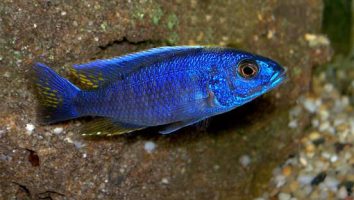The Bolivian ram is a beautiful freshwater fish that is native to Bolivia and Brazil.
This fish is a great addition to any freshwater aquarium, and is relatively easy to care for.
In this guide, we will go over everything you need to know about Bolivian ram care. We will discuss topics such as diet, tank size, tank mates, and more!
Table of contents
Species overview
The Bolivian ram (Mikrogeophagus altispinosa) is a freshwater fish that’s native to the Amazon Basin in South America.
They’re found in a wide variety of habitats, but they seem to prefer slow-moving waters with a lot of plants and hiding places. This is something to keep in mind when setting up their tank.
Bolivian rams are mostly peaceful fish, but they can be a little territorial toward their own species. It’s best to keep them in pairs or groups so that they can establish a hierarchy.
These fish are very popular in the aquarium scene because of their beautiful blue and gold coloration. They’re also relatively easy to care for, which makes them a great choice for novice aquarists.
Appearance

Bolivian rams are one of the more popular freshwater fish for aquariums. They’re small in size and have a very colorful appearance that really makes them stand out.
The body of the Bolivian ram is disk-shaped and flattened from top to bottom. They have a small head with a slightly protruding lower jaw.
One of the most notable features of this fish is their beautiful fins. They have long dorsal and ventral fins that are both decorated with colorful patterns.
The dorsal fin has a long filament that extends past the main body of the fin. The caudal fin is forked and fairly tall.
The coloring on Bolivian rams is very striking. They have a light silver-gray body with black spots all over. The fins are decorated with bright red, blue, and yellow.
Lifespan
The average lifespan of a Bolivian ram is around 3 to 5 years. There are a number of factors that impact their life expectancy.
For starters. if these fish haven’t reproduced then their lifespan will usually be on the higher side of this range. That process can really take a toll on the fish.
The general level of care they receive obviously matters a great deal as well. Even though these are very hardy fish, they’ll obviously live longer in optimal conditions.
Size
The Bolivian ram cichlid grows to be about 4 inches in length. These fish are relatively small compared to other cichlids, making them a good choice for smaller tanks.
Tank
Tank Size
The recommended tank size for Bolivian rams is at least 20 gallons. This is assuming you’re only keeping one fish and don’t plan on adding any tank mates.
If you want to keep more than one Bolivian ram in the same tank you’ll need to increase the size of the tank accordingly. For every additional fish you add you’ll need at least 5 to 10 gallons of extra space.
Water Parameters
The Bolivian ram is a freshwater fish that’s native to the Amazon Basin in South America.
As such, they’re accustomed to living in water that’s warm, slightly acidic, and has moderate hardness.
Maintaining these water parameters isn’t difficult, but it does require some basic knowledge of fishkeeping.
Here are a few guidelines to help you get started:
- Water temperature: 72 to 82 degrees Fahrenheit
- pH levels: 6.0 to 7.8
- Water hardness: 2 to 12 dGH
- Alkalinity Levels: 4-8 dKH
What To Put In Their Tank
When it comes to Bolivian rams, there are a few key things to keep in mind.
First and foremost, these fish come from slow-moving waters. This means that they’re not used to a lot of water movement in their habitat.
We recommend avoiding powerful filters and instead go with something that produces a gentle flow. You can even put an air stone in their tank to help with aeration if needed.
The second thing to consider is the plants in their tank. These fish love to nibble on vegetation, so anything that’s delicate is going to get destroyed.
We recommend going with something sturdy like Java Fern or Anubias. If you really want to include some floating plants, then Hornwort is a good option.
Finally, you’ll want to make sure there’s plenty of hiding spots in their tank. These fish are shy and need a place to retreat when they get scared.
You can achieve this by adding things like driftwood, rocks, or caves. Just make sure there’s enough space for them to swim around too!
Common Diseases
Bolivian rams are relatively hardy fish, but that doesn’t mean they don’t get sick from time to time. The most common illness that affects this species is ich.
This is a parasite that can quickly take over a fish’s body if it’s not dealt with. The first signs of ich are small white spots on the body and gills of your fish.
If this disease is left untreated it can be fatal, so it’s important to act fast if you notice any of these symptoms.
Other potential diseases include infections, parasites, and fungal growths. These are all relatively uncommon in Bolivian rams, but they can still happen from time to time.
As always, the best way to prevent these fish from getting sick is to maintain the quality of the water in their tank. A tank with clean and stable water conditions always leads to healthier fish who are more resistant to disease.
Behavior & Temperament
The Bolivian ram is a beautiful, peaceful fish that is perfect for the community aquarium. It is relatively small, only growing to about 3 inches in length, so it can be kept in a smaller tank.
This fish is very peaceful and can be kept with other peaceful fish of a similar size. It is not aggressive towards other fish and will not bother tank mates.
The Bolivian ram is a bottom dwelling fish that spends most of its time near the substrate. It will often be seen sifting through the substrate in search of food.
This fish is relatively easy to care for and is a good choice for the beginning aquarist.
Tank Mates
Bolivian rams are peaceful cichlids that can get along with most other fish species. They’re not overly aggressive and tend to stick to themselves.
However, because they occupy the middle to bottom of the water column, they can get along with most other fish as long as they’re not too small.
The main thing you need to watch out for is fish that are small enough to fit into the Bolivian ram’s mouth. Other than that, these fish are compatible with a wide variety of species.
Some good tank mates for Bolivian rams include:
- Neon Tetras
- Cardinal Tetras
- Black Neon Tetras
- Silver Hatchetfish
- Ember Tetras
- Glowlight Tetras
- Rummy Nose Tetras
- Buenos Aires Tetras
Breeding
Bolivian rams are one of the easier cichlids to breed in captivity. They’re not as picky as some other species and will readily spawn in most aquariums.
To increase your chances of success, start by setting up a breeding tank. It should be at least 30 gallons in size with plenty of hiding places. Driftwood, rocks, and plants all work well.
Next, add a pair of Bolivian rams to the tank. Make sure that you have one male and one female. You can usually tell them apart by their colors. Males tend to be brighter and more vibrant.
Once the rams have acclimated to their new surroundings, begin feeding them high-quality foods. A diet rich in protein will help to bring out their colors and prepare them for spawning.
When ready, the female will lay her eggs on a flat surface. It could be a rock, a piece of driftwood, or the glass of the tank. The male will then fertilize the eggs.
Once the eggs have been fertilized, the male will guard them vigilantly. He will also fan them with his fins to keep them oxygenated.
The eggs will hatch in about three days. At that point, you can remove the adults from the tank. The fry will feed on microscopic organisms in the water. You can supplement their diet with baby brine shrimp or crushed-up flake food.
As they grow, you can slowly start to introduce them to larger foods. Eventually, they will be large enough to join the adults in your main aquarium.
Conclusion
The Bolivian Ram is a beautiful and unique fish that is sure to add some flair to your aquarium. They’re not the easiest fish to care for, but with a little bit of knowledge and dedication, they can be a great addition to your tank.
If you’re looking for a fish that is a little bit different and that will stand out in your aquarium, the Bolivian Ram is a great choice.












